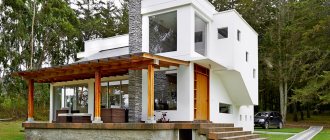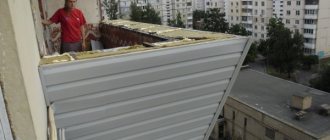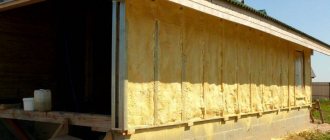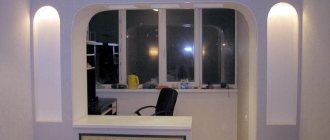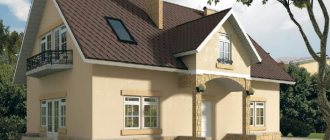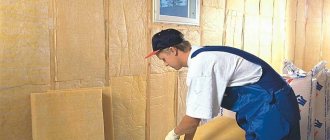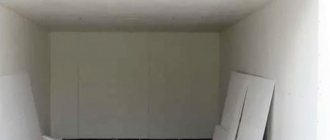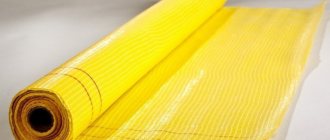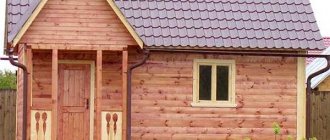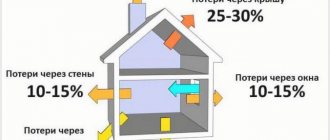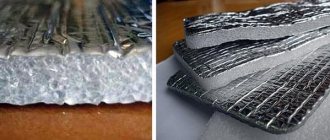Use of polystyrene foam
Polystyrene foam is a plastic material with a cellular structure. All internal voids are filled with gas, which ensures low thermal conductivity of the foam. Polystyrene foam is produced in the form of square sheets with a side size of 1 m and a thickness of 2, 3, 4, 5 and 10 cm. The material can have different densities, but the greatest demand is for foam with a density of 15-25 kg/sq.cm.
Foam plastic will certainly be of interest to those who are looking for ideas for quick, effective, and most importantly, not too expensive insulation of a balcony. What is the attractiveness of this thermal insulation material?
- Insulating a balcony with polystyrene foam will cost you little, since the prices for the material are quite affordable;
- Polystyrene foam is characterized by a low level of thermal conductivity;
- Foam plastic is non-toxic, therefore it does not require mandatory insulation during installation and operation;
- Polystyrene foam is easy to transport and install;
- Foam plastic is suitable for both external and internal insulation work;
- The polystyrene foam is practically not inhabited by pathogenic microorganisms.
What should you pay attention to when using polystyrene foam?
- Foam is loved by rodents, so you should protect the loggia from mouse attacks;
- It is not recommended to insulate with foam plastic in windy weather due to its high windage;
- Caution should be exercised when working with paints and solvents;
- Installing polystyrene foam inside the balcony will reduce the free space by 2-10 cm.
Material selection
The main issue in insulating balconies from the inside is the choice of material.
What is the best way to insulate a balcony? Now there are many types of insulation, but it is important to choose the most suitable one for yourself. Let's consider all the existing materials that are used to insulate balconies from the inside in more detail.
Mineral wool and polystyrene foam
Mineral wool is considered one of the most popular and high-quality materials for insulation today. It not only perfectly retains heat indoors, but also protects the balcony well from sounds from the street. The use of mineral wool and good double-glazed windows in combination will give perfect silence on the balcony even in the very center of the city.
Mineral wool is an inexpensive and effective heat insulator
The main advantages of insulating a balcony with mineral wool are fire safety and environmental friendliness. The material burns only at a temperature of 1000ºС, without releasing harmful chemicals into the air. In addition, cotton wool is an environmentally friendly material; it can be used in absolutely all rooms without fear.
However, it is important to take into account that when insulating a balcony with mineral wool, you must follow safety precautions. It is imperative to protect your face and body, as the smallest pieces of glass can cause severe itching if they come into contact with the skin. You also need to carefully lay mineral wool between the planks so that it does not bend in the future. To achieve maximum effect when insulating a room with cotton wool, it is better to use a waterproofing film. The thickness of the wool sheets can be any depending on the microclimate on the balcony.
As a rule, only the floor is insulated with expanded clay.
People often use ordinary polystyrene foam to insulate the inside of the balcony. This insulation for balcony walls is cheap, and working with it is quite easy and pleasant. Insulation does not require compliance with a specific scheme; polystyrene foam can be laid immediately before finishing the walls.
Foam can be used both thick (about 10 mm) and thin (5 mm). Everything depends on climatic conditions. You can even buy large sheets of polystyrene foam, and then cut them into smaller ones, adjusting them to fit the dimensions of the sheathing. This is very easy to do with an ordinary knife and a long ruler.
Foam sheets can be cut to fit the sheathing
Contrary to the opinions of many people, polystyrene foam is a safe material. It does not release any harmful substances into the air even at high temperatures. At the same time, it does not burn and, most importantly, does not deteriorate from moisture and does not sag. It is only recommended that when insulating, you immediately seal the gaps between the individual sheets so that cold air does not blow in there.
Using isolon
Another material with very attractive characteristics is isolon. Such a heat insulator will be an effective solution to the problem for those who are planning to insulate a loggia and at the same time want to save as much usable space as possible. Izolon is called foamed polyethylene. During its production, foaming of polymer raw materials is carried out in the presence of a special catalyst and under high pressure conditions. As a result, isolon takes the form of a rolled material consisting of thousands of sealed bubbles filled with air. Thanks to this structure, the thermal conductivity of isolon is very low, and sound absorption, on the contrary, is very high.
Another remarkable feature that insulating a balcony with this material has is that the heat is not only not released into the environment, but is reflected back into the room. This is possible due to the fact that the walls are finished with isolon, covered with foil on the outside.
Other characteristics of isolon include complete moisture resistance, resistance to gasoline and other petroleum products, and complete safety for human health.
Very often, isolon is used not as an independent insulation, but as one of the layers of the “thermal insulation cake”. Thus, insulation with polystyrene foam with an additional top layer of isolon shows good results.
Izolon is supplied in rolls, so before installation it must be cut into pieces of suitable sizes. The joints between the pieces are glued with ordinary stationery or special construction tape.
Insulation with isolon from the inside reviews
posted 13-3-2010 13:21quote: Originally posted by P-Alex:
but I wanted to shoot something like Izolon 10mm from below with a stapler to the floor boards. Perhaps this will be wrong due to poor vapor permeability?
Hello friends, I need feedback from anyone who has covered garage walls with a material such as isolon. I need a sensible review, will it be of any use, or should I not bother sewing up my brains with polystyrene foam. the garage is currently used as a repair garage, there is a potbelly stove that warms it up to +20, but the problem is that it cools down to -5 overnight, when the temperature outside is -15. the garage is in the center of the row.
Comments 51
Kind! The issue is already 4 years old... How did you solve it?
I have exactly the same configuration. permanent garage (slabs 12cm thick) 3.5*7 ceiling height 2.30. I poured 4cm of polystyrene onto the ceiling, reinforced the iron gates with polystyrene foam and then sewed them up with OSB. I sealed the cracks in the doors with a mat.
otherwise exposed concrete. It has been experimentally established that 15 kW thermal electric. the gun heats the garage from 0 to 15 in about 15 minutes (at an outside temperature of -10).
The actual question is if you cover the ceiling with additional insulation to reflect heat and the walls. will there be: 1) the effect of faster warming up 2) will the cooling slow down?
I only made it on the walls and that’s it, the ceiling is a slab, there’s a path on it with 3 cm foam. There’s nothing else, and yes, the insulated gates are also 3 cm foam and plywood on top, I haven’t seen less than -18 in the garage at a temperature outside of -45. The garage is rarely heated now, and only from a potbelly stove. I haven’t stopped by for a month to check the thermometers -15 although the frost was down to -50. It has a quick heating effect and doesn’t take much longer to cool down. In principle, this is enough for me for now, since I haven’t been using the garage much lately. The new garage will be insulated on the wall with isolon on top, polystyrene 2 cm on top, everything will be sewn up with USB panels. But there will be more of a thermos effect. And the heating will be electric. Floor with water circuit and 8 radiators.
ok, question number 2 is no less important. Insulation from the inside produces condensation. playing with the calculator. Heat Calculation.rf/?r >
I realized that foiling by reflecting heat should remove condensation, since the walls will not warm up so much. What do you say?
And about electricity. and batteries, I already understood the following. batteries solve only the issue of heat removal and delivery. If the garage is small, then they are not necessary, you can solve it with a fan.
and in principle it doesn’t matter what you drown it with. Insulating a garage gives you the conditions for how many kW of heat you should provide for heating, and how much for maintenance. The better you insulate, the lower these numbers will be.
It turned out that to maintain +15 you need 5 kW of heat per hour, to heat up 15 kW for 10-15 minutes.
Right now the walls are dry behind the insulation, there’s honestly not much difference in how quickly it cools down, right now when the stove goes out, after about half an hour the garage starts to cool down. It serves more to prevent the stoves from heating up and to reflect the heat that comes from the heaters. Even when in a +25 garage you put your hand behind the isolon, the slab is icy, but most importantly, dry. When there was no stove, I heated it with a gas gun, so there was about 2 centimeters of ice on the walls all over the garage until the summer I couldn’t get rid of it. Last year I tried to use a cannon to replace the stove for a couple of days; there was nothing like that on the walls. So, as advice, first insulation, then insulation and sew up on top. Don’t listen to these smart guys who have read a lot about the dew point and TD that you only need to insulate the outside, just do it first with insulation and see how it goes, if there is little effect and then you can cover it with something on top. It took me 4,000 rubles for 60 square meters. Plus dowels with self-tapping screws, well, about 500 rubles.
I understand that isolon should be the final authority. and under it, accordingly, there is insulation.
that is, isolon reflects heat inward, polystyrene foam prevents the heat from the foil from heating the concrete. and since the wall is not heated relative to the street, then there will be no condensation.
I’m thinking of replacing the dowels with foam glue. dowels = cold bridge.
Isolon alone will not give anything, I covered the ceiling with 4mm thick, as the boards and beams froze, so it freezes, actually I wanted to remove this moment so that it wouldn’t drip on my head, and it didn’t work out, so just penoplex or polystyrene foam with foil on top.
In recent years, insulation materials have been developed for a variety of needs: extruded polystyrene foam panels, rigid basalt slabs or thick mineral wool mats. Each of them performs the required functions, but sometimes they cannot be used - due to humidity, installation difficulties or other reasons. The solution to the problem in such situations can be “Penofol” insulating material, which combines both absorbent and reflective insulation.
It is made of foamed polyethylene, which has been shaped into a thin layer and covered with a layer of aluminum foil on one or both sides. For ease of use, it is produced in three types:
“Penofol-A” – covered with foil film on one side to prevent heat from escaping;
“Penofol-B” - covered with foil on both sides to reflect heat waves in two directions, i.e. coming both from inside the room and outside;
“Penofol-C” - on one side there is a foil film applied, on the other, in turn, there is a self-adhesive surface, which increases the ease of installation significantly. Used for insulating hard-to-reach places or simply for speed of work.
Such insulation requires a minimum of space: up to 10 mm thick. According to reviews, Penofol will cope well with hydro- and vapor barriers. The material is truly universal: if you use it correctly and work well with the joints, you can achieve good heat and sound insulation.
How's it going with penoplex?
Penoplex is a more modern analogue of polystyrene foam. Accordingly, the insulation of the loggia using it is carried out using a similar technology. Penoplex is called extruded polystyrene foam. If you come across the abbreviations XPS or EPS, then know: we are talking specifically about penoplex. Its main difference from polystyrene foam is its higher density, which means greater rigidity and resistance to damage due to mechanical stress. For comparison: if foam plastic for thermal insulation work is chosen with a density of 10-25 kg/sq. cm, then penoplex – 35-45 kg/sq.cm. The increased rigidity of this material makes it an ideal heat insulator not only for walls, but also for balcony floors. Coverings made from OSB panels can be laid directly on polystyrene foam, without installing joists.
Other attractive characteristics of penoplex
- Ease of installation due to the presence of special grooves along the edges of the plates;
- Long service life - up to 40 years;
- Moderate level of combustion toxicity (T2).
Features of installation of foil vapor barrier ↑
The main task of a vapor barrier is to protect the insulation and walls from moisture penetration inside. This function is the starting point when installing panels in different rooms.
- When assembling a “cold” roofing pie, metallized strips of material are mounted in the ceiling (recommended for the ceiling), from the inside of the room with the foil down.
- If installation is carried out for a house in the attic, then the foil vapor barrier is laid with the metal side inside the room on top of the laid insulation on the inside of the roof slopes. Fix the film with a stapler and counter-lattice slats.
- In the bathhouse, foil vapor barrier is installed on all planes, on the floor, walls and ceiling. The foil surface is turned inside the room.
When installing layers, you should adhere to the technological laying rules:
- All wooden parts of rafter systems and other building elements should be carefully inspected for protruding sharp edges or fasteners to avoid damage to the film during installation.
- Before you begin installing the insulation, you should treat all wooden parts of the structure with an antiseptic. This will extend the life of the material and is guaranteed to eliminate problems such as the formation of fungus and mold.
- Vapor barrier layers on any planes (roof slopes, walls, interfloor ceilings) must be continuous. The porous structure does not require ventilation gaps. The mounted panels are connected hermetically using foil tape.
- Laying of vapor barrier is carried out only in a horizontal position, according to the scheme from top to bottom. That is, the first strip is mounted near the ridge, the second lies lower, overlapping the first.
- When laying sheets of material, releases are made on walls and other nearby areas. The width of such strips should be at least 150-200 mm.
- Fastening in attics, attics and ceilings is carried out with a stapler. Additional fixation is performed with sheathing slats, which can later be used as a base for the internal cladding.
- All joints of the panels are taped with foil tape.
Foil vapor barrier is a specific material, but it is recommended to use it to improve the energy-saving properties of premises. However, in order to effectively use such films, you need to take into account their characteristics, as well as the conditions of a particular room. It is not economically feasible to use metallized vapor barrier in interior rooms without the formation of high temperatures and high humidity. Conversely, for an attic or bathhouse, it is best to use precisely those layers of vapor barrier where they will be fully effective.
Mineral wool - a proven option
Mineral wool based on glass, slag or stone is one of the best sellers in the modern market of thermal insulation materials. Insulating a loggia with such material will also be relatively inexpensive, which, however, will not affect the quality in any way.
Mineral wool is supplied both in the form of rolls and in sheets packed in bales. Its internal structure can be layered (horizontally and vertically), as well as spatial or corrugated. It depends on the raw materials used in the manufacture of mineral wool.
The thickness of the mineral wool layers varies from 20 mm to 20 cm. For maximum effective insulation, wool is used, covered on one side with foil. This, firstly, facilitates installation, and secondly, helps to reflect heat back into the room.
In addition, mineral wool
- is resistant to temperature changes;
- does not collapse under the influence of chemical reagents;
- provides excellent sound insulation;
- does not require preliminary leveling of the walls.
However, please note that when working with mineral wool, you should be careful, namely, use special clothing and personal protective equipment (gloves, goggles, respirator). This is necessary to prevent the negative effects of dust and formaldehyde resins on your health.
Main types of material
On the market of thermal insulation materials you can find two types of isolon. These are PPE (polyethylene foam), NPE (non-crosslinked polyethylene foam).
PPE is a physically cross-linked polyethylene foam with a closed cellular structure. NPE – gas-foamed polyethylene foam, the molecules of which do not have chemical bonds with each other
Technical characteristics of PPE and NPE
PPE is a very light material. By insulating your balcony with isolon, you minimize the possible load on the balcony slab. The material perfectly soundproofs the room and, due to its structure and foil coating, is capable of reflecting heat into the room. It is soft, elastic, and allows you to insulate even the most inaccessible places. It has considerable durability: it can serve its owners for almost a century (more than 90 years). Environmentally friendly, versatile. Can be used at temperatures from -60 to 75 degrees Celsius. It can be purchased at any building materials store and in the required thickness, which makes it accessible to the masses of consumers. During installation, even beginners are unlikely to have any difficulties.
NPE has a less dense structure and a maximum thickness of up to 16 mm. This type has lower thermal conductivity and weaker protection of the room from sounds. Vapor permeability and water absorption are comparatively lower. Mainly used as packaging material.
Foiled polystyrene foam is the best solution
What is insulation of a balcony with such material? Expanded polystyrene is also called gas-filled polystyrene. To minimize heat loss, it is equipped with a backing made of aluminum foil.
Although the moisture absorption of polystyrene foam does not exceed 0.25 mm per year, it is not recommended to install it on a floor or wall that is subject to dampness, since the foil will not allow them to dry out properly. As a result, mold or mildew may develop under the polystyrene foam.
Expanded polystyrene is resistant to temperature changes in the range of 80°: from minus 40°C to plus 40°C. This heat insulator exhibits the same stability when interacting with alcohols. The integrity of expanded polystyrene can be damaged only by the action of solvents, but when insulating a balcony it is quite possible to do without the use of such means.
Expanded polystyrene is considered a very flammable material. Its ignition occurs already at 210-310 °C, so the most serious manufacturers add fire retardants to the raw materials, which significantly reduce the flammability of polystyrene foam. The presence of such components in the heat insulator can be recognized by the letter “C” in the material marking, for example, PSB-S.
As a rule, expanded polystyrene is supplied in the form of rolls 1 m wide. The thickness of the insulation is 10-50 mm.
Materials for insulating a loggia: how to make the right choice
In order for your balcony or loggia to turn from a cold storage room into an additional room in your apartment, it must be renovated accordingly. The first thing you need to do is install new, energy-efficient windows. After which the balcony must be insulated.
You will find materials for insulating a loggia or balcony in almost any construction supermarket. There are many of them, and they differ in structure, composition and quality. But they carry the same task - insulation.
Also, all materials have different prices. There are those that are expensive, and not everyone can afford them. But there are also inexpensive, budget options. In addition to insulation, for the corresponding work you will also need wooden or metal beams for sheathing, fasteners, adhesive materials and polyurethane foam.
Materials for insulating a balcony can be:
- Polyurethane foam;
- Penoplex;
- Izolon or penofol;
- Styrofoam;
- Expanded polystyrene;
- Expanded clay;
- Mineral wool.
Sometimes when insulating a balcony, two or more types of finishing materials are used.
Expanded clay
Expanded clay is produced by thermal transformation of low-melting clay. As a result, expanded clay takes the form of granules with a porous structure. During thermal insulation work, expanded clay is used only as backfill at the stage of floor insulation. Expanded clay is especially suitable for arranging wooden floors.
Expanded clay absorbs water well, but releases it slowly, so it is recommended to cover the backfill with plastic film before pouring the concrete screed. Please note that the thickness of the screed must be at least 5 cm, otherwise cracks may appear.
Insulation of ceiling and floor with Izolon
Metallized lavsan film Izolon.
The simplest option for insulating a floor with Izolon is to use it as a lining under a laminate, although it is also possible to lay linoleum on top of foamed polyethylene. In addition, this material can be used in structural elements of a building, for example, on the ceiling and wooden floor laid on joists. The installation technique in both cases is very similar, so we will consider them together.
Naturally, Izolon thermal insulation as an independent insulation gives insignificant results, since its thickness is too small. Therefore, in order to get a high-quality thermal insulation cake, you need to use more solid insulation materials, for example, mineral wool. In this case, in addition to auxiliary protection against heat loss, foamed polyethylene can act as a vapor barrier. Mineral wool, especially glass wool, is prone to absorbing moisture from the air, especially if it is laid on the ceiling. Therefore, insulating the ceiling with Izolon in some cases is not only desirable, but necessary.
Correct insulation method:
- Mineral wool is laid between the floor or ceiling joists;
- Izolon is tensioned along the joists;
- the counter-lattice is stuffed;
- finishing is being installed.
It is quite acceptable to lay this material directly under the finishing, as sound insulation. To do this, it is enough to secure the material with a construction stapler on the working surface end-to-end and seal the joints with tape. If it is technically possible, it is better to leave a gap between the polyethylene foam and the finish. Even if there is moisture on the insulation, it will successfully evaporate and will not be absorbed into the finishing materials, which will significantly extend their service life. Many people are interested in the question of whether it is possible to insulate the floor with Izolon in a wooden house. This is allowed, but again, as independent thermal insulation, it gives almost no results.
Rigid thermal insulation cylinders made of mineral wool are used to insulate communications.
You can read about which non-flammable insulation materials for roofing are best here.
Penofol
Insulation of loggias, interfloor, basement and attic floors, foundations, roofs - all this work can be carried out with penofol. This material is suitable for both external and internal thermal insulation.
The most commonly used types of penofol:
type A – foil-coated on one side; type B – foil coated on both sides; type C – foiled on one side and covered with a self-adhesive backing on the other; types R and M – embossed (foiled on one side); ALP type – foil-coated on one side, laminated with polyethylene film on the other.
